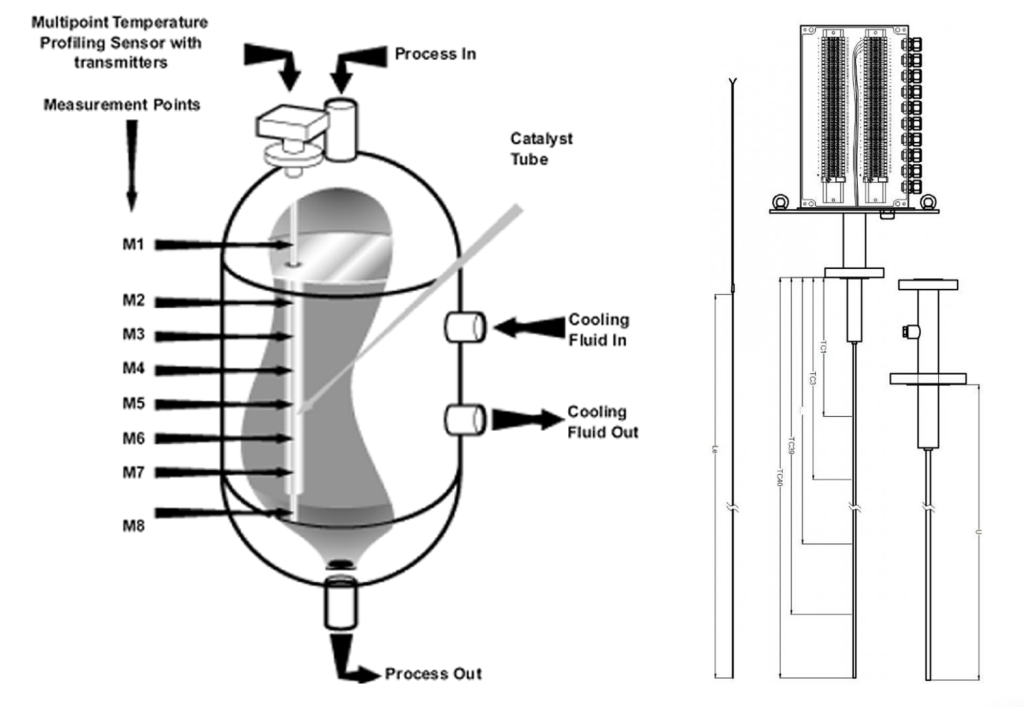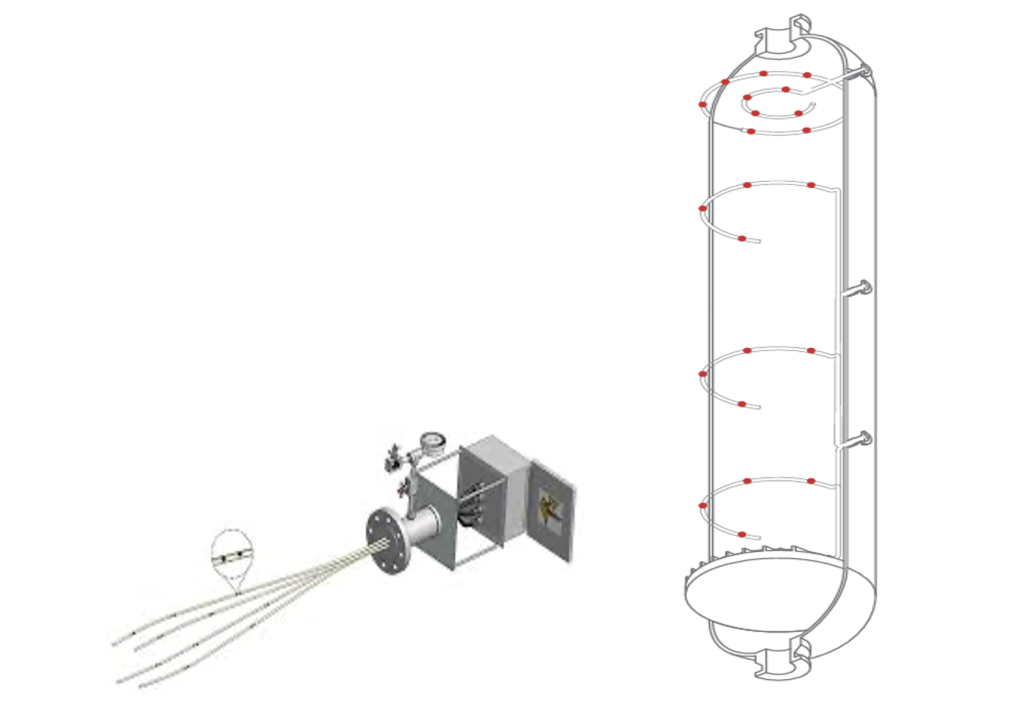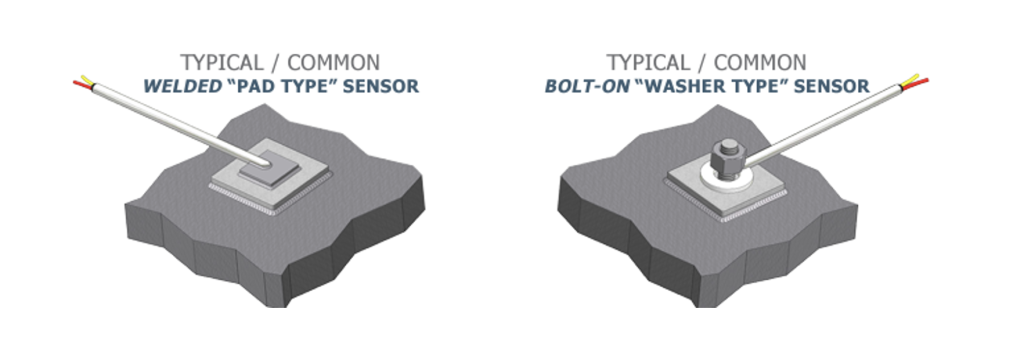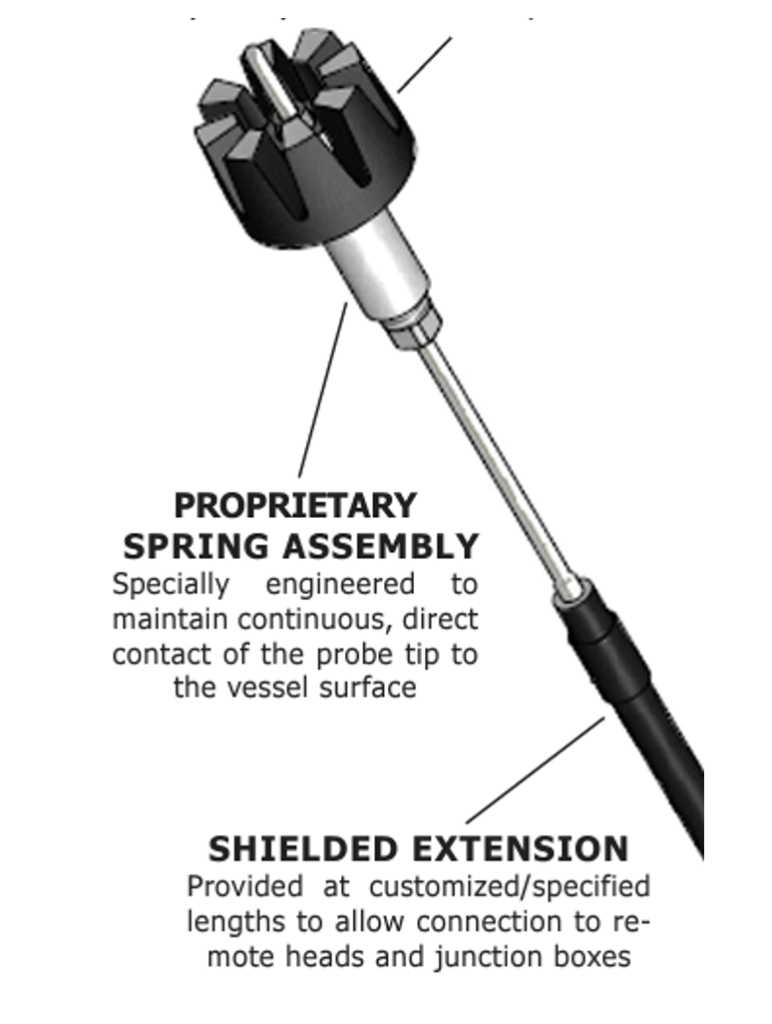Temperature measurement in a hydrocracking process is crucial for maintaining optimal reaction conditions and ensuring the desired product yield and quality.
What is Hydrocracking?
The Hydrocracking Process
Hydrocracking is a catalytic chemical process in refining that converts heavy hydrocarbon feedstocks, such as vacuum gas oil or atmospheric residue, into lighter, more valuable products like gasoline, diesel, and jet fuel. During hydrocracking, sulfur, nitrogen, and oxygen are nearly completely removed, and olefins are saturated, resulting in products that are primarily a mix of pure paraffins, naphthenes, and aromatics. This process combines catalytic cracking and hydrogenation in a single process, enhancing the yield of desired products and reducing the sulfur content.
Globally, the energy sector is decarbonizing energy production by substituting fossil feedstocks with renewable resources and processing them within the existing refinery infrastructure. This process is already widely used by refineries around the world to create fuels that are fully compatible with today’s hydrocarbon fuels and accounts for 4% of the global production of renewable transport fuel [1]. Hydrocrackers are capable of co-processing renewable feedstocks, especially those of the more challenging second and third generations. Some examples of renewable feedstocks that can be used in hydrocrackers include [1]:
- Oilseed crops
- Grains and sugar crops
- Biomass from waste
- Used cooking oils
- Animal fats
- Tires
- Ligno-cellulosic biomass from agricultural waste
Key Steps in Hydrocracking:
- Feed Preparation: The heavy oil or renewable feedstock is preheated and mixed with hydrogen gas before entering the hydrocracking unit.
- Pre-treatment (Hydrotreating): The mixture is often passed through a hydrotreating section where impurities such as sulfur, nitrogen, and metals are removed to protect the catalyst and improve product quality.
- Hydrocracking Reactor: The treated feedstock is introduced into the hydrocracking reactor containing a catalyst typically made of noble metals (e.g., platinum or palladium) on acidic supports (e.g., zeolites or alumina). Reaction conditions are high temperatures (530-890°F / 276-476°C) and high pressures (500-3000 psi). In the presence of hydrogen, large hydrocarbon molecules are cracked into smaller ones. The introduction of varying types and quantities of renewable feed into the process leads to the formation of new reactions and products.

- Separation: The reactor effluent is cooled and sent to a high-pressure separator where hydrogen gas is recycled back into the system. Liquid products are then directed to a fractionation column.
- Fractionation: The fractionation column separates the hydrocracked products into various fractions based on boiling points, such as naphtha, kerosene, diesel, and heavy residuals.
- Product Treatment: Separated products may undergo further treatment to meet particular specifications. For example, naphtha might be sent to a reformer to produce high-octane gasoline.

Basics of Temperature Measurement
Temperature measurement in hydrocracking is not just a matter of monitoring but is a critical component of process control and safety that influences every aspect of the operation. This section covers the fundamentals of temperature measuring devices including thermowells, temperature sensors, and transmitters.
Thermowells
- Purpose: Thermowells serve as protective enclosures for temperature sensors, shielding them from harsh process conditions such as high pressures, corrosive substances, and abrasive materials.
- Design: Typically constructed from durable materials such as stainless steel, alloy metals, or ceramic, thermowells are designed to withstand the extreme conditions prevalent within hydrocracking reactors.
- Types: Thermowells come in various designs, including threaded, flanged, and welded configurations, each tailored to specific installation requirements and process environments.
- Functionality: By providing a barrier between the process fluid and the temperature sensor, thermowells enable safe and reliable temperature measurement while facilitating ease of maintenance and sensor replacement.
Temperature Sensors
The most common type of temperature sensors are thermocouples that function based on the Seebeck effect, wherein a temperature difference between two dissimilar metals generates a voltage proportional to the temperature. Specifically in hydrocracking applications, thermocouples offer several advantages over other types of temperature sensors:
- Faster Response Time: Quickly detect temperature changes, ideal for dynamic processes where real-time monitoring is critical
- Higher Temperature Range: Measure a broad range of temperatures, often up to and beyond 2300°F / 1260°C, which is necessary for high-temperature environments
- Durability: Robust and can withstand harsh and corrosive conditions, ensuring long-term reliability in demanding process environments
- Intrinsically Safe: Suitable for use in hazardous environments since external power source is not required and less likely to cause ignition in explosive atmospheres

Transmitters
- Transmitters serve as the interface between temperature sensors and control systems. Additionally, transmitters provide protection against electrical noise deteriorating or disrupting the signal, and provide functionalities such as sensor matching, diagnostics, safety integrity level (SIL) ratings, and local indication for thermocouples and resistance temperature detector (RTDs) that are otherwise blind to the local operator [3].
- Modern transmitters typically accept either RTDs or thermocouples of any denomination. They often incorporate features such as signal linearization, cold junction compensation (for thermocouples), and diagnostic capabilities to enhance accuracy and reliability. The most common communication protocol in use is Highway Addressable Remote Transducer (HART) over a 4-20 mA signal. Digital and wireless protocols also exist, providing a variety of mechanisms to communicate the measurement signal back to an instrument charged with the task of monitoring or control.
- Transmitters seamlessly integrate into distributed control systems (DCSs) or programmable logic controllers (PLCs), providing real-time temperature data for monitoring, control, and analysis.
- Transmitters may be panel-mounted, field-mounted, or integrated directly into temperature measurement assemblies, offering flexibility in installation and maintenance.
Importance of Temperature Control
Temperature control in the hydrocracking process will optimize reactions, preserve catalyst integrity, increase product quality, maintain process safety, improve energy efficiency, and achieve operational stability.
Different hydrocracking reactions occur at different temperatures; therefore, maintaining the right temperature will help to achieve the desired selectivity towards specific products. Catalytic reactions are exothermic and perform best at the optimal temperature, and hydrocracking reaction in biofuel production is even more strongly exothermic. While high temperatures can temporarily boost activity and increase the reaction rate, an exothermic chemical reaction in the reactor has the potential to cause a thermal runaway. A temperature excursion can lead to serious consequences, such as [7]:
- Over-pressurization and potential mechanical failure of the reactor
- Damage to catalyst
- Loss of containment, potentially causing explosions and fires
- Environmental release of hydrocarbons and sulfur compounds
- Potential injury and death
- Prolonged downtime and loss of production
Most hydrocracking units are equipped with emergency shutdown systems that depressurize the reactors during such an event. However, it is preferable to prevent temperature excursions from occurring in the first place, thereby avoiding the need for depressurization [7].
When liquid becomes trapped in the catalyst, a blockage occurs and the liquid cannot move in the radial and axial directions, thus forming a local hotspot – or localized area with maximum temperature – which is a major issue in bed reactors. Local maldistribution is another mechanism that can cause a hotspot. A hotspot can negatively impact product yield, deactivate the catalyst, and potentially cause a loss of containment if it occurs near the reactor wall [8].
Measurement Locations:
Inlet of the Reactor:
- Feed Inlet: Measuring the temperature of the feedstock as it enters the reactor determines if the feed is at the optimal temperature for the hydrocracking reactions.
- Hydrogen Inlet: Monitoring the hydrogen inlet temperature helps ensure it is properly preheated for efficient mixing and reaction with the feedstock.
Catalyst Beds :
- First Catalyst Bed: Temperature measurement at the top of the first catalyst bed provides data on the initial reaction conditions and the temperature rise due to exothermic reactions.
- Subsequent Catalyst Beds: Each additional catalyst bed should have a temperature measurement on top to monitor the temperature profile and manage heat distribution within the reactor.
- Middle Sections: Placing sensors in the middle of each catalyst bed gives insight into the temperature gradient and reaction progression within the bed. This helps to detect hotspots or uneven temperature distribution that could affect catalyst performance and product yield.
- Last Catalyst Bed: Measuring the temperature at the bottom of the last catalyst bed ensures that the reactions are complete and the effluent is at the desired temperature before moving to the next process unit.
- Inter-Bed Zones (Between Catalyst Beds): Monitoring temperatures between catalyst beds provides information on the heat exchange efficiency and assists in the detection of any potential issues with heat distribution or catalyst deactivation.
Reactor Outlet:
- Product Outlet: Measuring the temperature of the hydrocracked product as it exits the reactor ensures it meets the desired specifications and helps in assessing the overall reactor performance.
Wall Temperature:
- Reactor Wall: Temperature sensors placed on the reactor walls monitor the external temperature, thus providing data on heat losses and supporting thermal management and insulation efficiency.
Hydrocracking Temperature Measurement Techniques:
Proper placement of temperature sensors is crucial for obtaining representative measurements, as incorrect placement often leads to inaccurate readings and suboptimal process control. When using alternative feedstocks, the accurate temperature measurement is critical to process efficiency and safety.
Single-Point Measurement: A traditional temperature measurement technique which uses a single thermocouple in a rigid thermowell. It measures only one point per well and risks potential sealing issues, poor flow distribution, and hazardous leaks if the thermowell fails.

Rigid Multi-Point System: Designed to improve the reliability and accuracy of industrial-grade temperature sensors by incorporating multiple sensors into a robust structure. This system enables the retraction of the sensor probe from the protective well and the insertion of a replacement sensor, addressing issues such as sensor calibration drift, erratic readings, and unresponsiveness.

While these rigid multi-point systems offer a significant improvement compared to measuring only one or two locations, they also present the following issues:
- Rigidity of the protective well restricts sensor placement flexibility.
- Increases the likelihood of catalyst loading problems, process flow disruptions, and maldistribution.
- Heat transfer from the catalyst temperature through the protective well to the sensor slows significantly, causing a lengthy delay in response time from temperature change to data recognition [10].
- Practicality of sensor removal with the reactor in operation is questionable due to the high process temperature. In addition, breaking the seal (removing the flange) can potentially expose maintenance personnel to hazardous reactor contents if the integrity of the well has been breached.
Flexible Multi-Point Systems: Accurately monitoring catalyst utilization and condition is crucial for optimizing performance. Relying on inadequate or outdated temperature instrumentation can severely impact profitability. Modern high-activity catalysts demand precise temperature control that outdated reactor profiling systems cannot provide [6]. Oftentimes, plants use flexible thermocouples routed inside reactors and constructed with mineral-insulated cables and safety seal chambers to prevent leaks. This system offers flexible routing, faster response times, and higher point density with fewer nozzles; unfortunately, the system does not support online sensor replacement, may experience sensor failures, and requires extensive installation support.

Surface or Skin Temperature Measurement: Operating at high pressures and temperatures can make critical vessels and reactors susceptible to failures at compromised joints and refractory linings, which means surface or skin temperature measurement is critical to detecting potentially unsafe operational conditions. Skin or surface temperature measurement can protect surfaces from overheating and monitor for extreme temperatures and critical points on reactors or vessel surfaces [8].
Skin temperature sensors are attached directly to reactors or vessel surfaces via welded pads or washer type. For ferritic surfaces, magnetic non-welded sensors are available, eliminating the need for hot work and subsequent welding.


Maintenance and Reliability
In the hydrocracking process, even minor deviations from the optimal working temperature can lead to significant inefficiencies, especially in the reactor where temperatures must be continuously monitored and adjusted as needed. Loss of temperature control in the reactor can create unsafe operating conditions, potentially forcing a shutdown. A robust maintenance program will protect the reliability and accuracy of temperature sensors, prevent unplanned downtimes, enhance process safety, and maintain optimum reactor performance.
Common Failure Modes:
- Sensor Aging: Thermocouple wires are susceptible to degradation due to oxidation, corrosion, and mechanical wear, all of which reduce thermoelectric voltage output and result in inaccurate temperature readings or sensor malfunction. Carefully selecting and installing thermocouple wires will help reduce premature failures.
- Sensor Drift: Loss of accurate temperature readings due to physical changes in the thermocouple metallurgy are a result of high-temperature exposure and repeated measurement cycles. Although drift is inevitable as thermocouples age, advancements in metallurgical science may lead to the development of more durable thermocouples with extended lifespans.
- Circuit Failures: Discontinuities or electrical interference in thermocouple wiring, caused by physical damage, corrosion, or improper installation, can disrupt the flow of thermoelectric current, resulting in inaccurate readings or complete sensor failure.
- Insulation Failure: Thermocouple insulation can be compromised by mechanical and thermal stress, causing circuit malfunctions and inaccurate temperature readings. Ensuring proper installation will help to prevent premature insulation failure.
Preventative Maintenance:
- Routine Calibration will increase accuracy by regularly comparing thermocouple readings with a known standard. This practice will maintain precise temperature control, prevent unsafe conditions, and meet regulatory standards.
- Visual Inspections are necessary to help proactively identify physical damage, wear, or corrosion. Early detection allows plants to conduct proactive repairs or replacements which will minimize downtime and maintain the reactor’s efficiency and reliability.
- Routine Maintenance includes regularly cleaning and maintaining the reactor to prevent corrosion, maintain signal integrity, and extend the sensors’ lifespan. Regular removal of deposits will support the thermocouples in continuing to function properly and provide accurate temperature readings for precise process control.
- Environmental Protection measures the safeguards in place to protect thermocouples from extreme temperatures, moisture, and corrosive substances. By enhancing their durability and performance, plants will get consistent temperature readings even in harsh conditions, which is necessary for process stability and cost-effective operations.
Safety Instrumented System (SIS) Safeguarding: The integration of temperature sensors into a safety instrumented system (SIS), in accordance with ANSI/ISA 61511, is required for the automatic depressurization of the reactor under unsafe operating conditions. The appropriate SIL for high-temperature scenarios in hydrocracking processes can be determined using qualitative or quantitative tools such as HAZOP, risk graphs, layer of protection analysis (LOPA), and quantitative risk analysis (QRA) [13].
Conclusions
In conclusion, implementing reliable and accurate temperature measurement at a refinery is important to achieve effective process control, maximize product yield and quality, and extend catalyst life. Implementing advanced temperature measurement technologies, such as flexible multipoint systems along with a robust maintenance program for temperature sensors, enhances the accuracy and reliability of temperature data. In turn, this supports the efficient, safe, and profitable operation of hydrocracking processes. As the energy sector transitions towards decarbonization, integrating renewable feedstock into existing hydrocracking infrastructure reinforces the significant role of precise temperature control for maintaining process stability and meeting the evolving demands of sustainable energy production.
Equity can assist in providing comprehensive temperature measurement solutions. Our services include:
- Designing a temperature measurement system, including sensor selection and placement
- Developing reliability programs for the temperature measurement system
- Implementing temperature measurement system into plant control systems and safety systems
- Integrating renewable feedstock
- Providing technical support for process optimization
If you have any questions for the authors, please submit the form below:
References:
[2] https://citizendium.org/wiki/File:Hydrocracking_process.png
[3] API Recommended Practice 551 Second Edition, February 2016
[4] https://www.thermo-electric.com/wp-content/uploads/2016/05/designers_guide_mult.pdf
[5] https://www.rodax-europe.com/products/multipoint-reactor-temperature-assemblies/
[6] https://www.dailyinst.com/site/assets/files/1194/daily_thermetrics_cattracker_brochure_2020_3_9.pdf
[8] https://trepo.tuni.fi/bitstream/10024/116374/2/BahiraeiLeila.pdf
[9] https://www.costacurta.com/applications/refining/hydrocracking/
[13] https://www.kenexis.com/wp-content/uploads/2014/05/HydrocrackerSafeguarding.pdf





